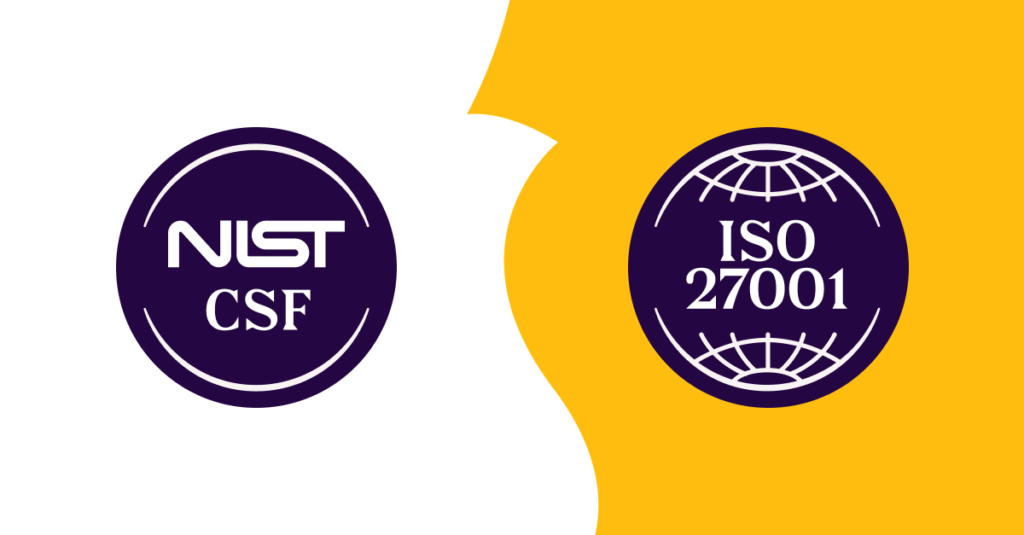In today’s digital landscape, organizations face numerous cybersecurity challenges that require robust frameworks to protect sensitive information. Two popular frameworks widely used for this purpose are the NIST Cybersecurity Framework (NIST CSF) and ISO 27001. While both frameworks aim to enhance cybersecurity posture and mitigate risks, they differ in their approach, requirements, and scope. This article will delve into NIST CSF vs. ISO 27001, helping you understand their unique features and decide which framework aligns better with your organization’s needs.
As cybersecurity threats continue to evolve, it becomes crucial for organizations to implement effective strategies to safeguard their digital assets. The NIST CSF and ISO 27001 provide comprehensive frameworks that assist organizations in managing cybersecurity risks.
Contents
NIST CSF

The NIST Cybersecurity Framework (NIST CSF) was developed by the National Institute of Standards and Technology (NIST) in response to the increasing frequency and sophistication of cyber attacks. Its primary objective is to provide organizations with a flexible and adaptable framework to manage and mitigate cybersecurity risks.
The NIST CSF comprises five core functions: Identify, Protect, Detect, Respond, and Recover. Each function plays a vital role in establishing a robust cybersecurity posture. By implementing the NIST CSF, organizations can identify and prioritize their assets, assess risks, establish protective measures, and effectively respond to and recover from cyber incidents.
The benefits of adopting the NIST CSF include improved risk management, enhanced communication among stakeholders, increased awareness of cybersecurity, and alignment with industry best practices.
ISO 27001
ISO 27001 is an internationally recognized standard for information security management systems (ISMS). It provides a systematic approach to managing sensitive information and ensuring its confidentiality, integrity, and availability.
ISO 27001 emphasizes a risk management-based approach, requiring organizations to identify, assess, and treat information security risks systematically. It encompasses various processes, including risk assessment, security policy development, asset management, personnel security, and incident response.
Achieving ISO 27001 certification demonstrates an organization’s commitment to information security and compliance. The standard offers numerous benefits, such as increased customer trust, improved internal processes, legal and regulatory compliance, and competitive advantage in the marketplace.
Difference Between ISO 27001 and NIST CSF

While both NIST CSF and ISO 27001 aim to enhance cybersecurity, they differ in their approach, scope, and requirements. Here are some key distinctions:
- Approach and Scope: NIST CSF provides a high-level, risk-based approach, offering organizations flexibility in implementing cybersecurity practices. On the other hand, ISO 27001 focuses on establishing an Information Security Management System (ISMS) with specific requirements for documentation, controls, and continual improvement.
- Risk Management: NIST CSF places a strong emphasis on risk management throughout its framework. It encourages organizations to assess and prioritize risks, implement protective measures, and continuously monitor and respond to emerging threats. ISO 27001 also includes risk management as a core component but provides more prescriptive guidelines on risk assessment and treatment.
- Compliance Requirements: ISO 27001 is a formal standard that requires organizations to meet specific compliance requirements to achieve certification. It involves rigorous documentation, audits, and external assessments to ensure adherence to the standard’s requirements. NIST CSF, on the other hand, is a voluntary framework that does not offer formal certification. It provides organizations with guidelines and best practices without imposing strict compliance obligations.
- Flexibility and Adaptability: NIST CSF offers greater flexibility and adaptability compared to ISO 27001. Organizations can tailor the framework to their specific needs, making it suitable for a wide range of industries and sizes. ISO 27001, while adaptable to some extent, follows a more standardized approach and may require more effort to align with specific organizational requirements.
Choosing the Right Framework

When deciding between NIST CSF and ISO 27001, organizations should consider several factors:
- Industry-specific Considerations: Some industries, such as healthcare or finance, may have specific regulatory requirements that favor one framework over the other. It is important to evaluate the alignment of each framework with industry-specific regulations and compliance obligations.
- Risk Appetite and Maturity: Assessing the organization’s risk appetite and maturity level is crucial. NIST CSF is more suitable for organizations seeking flexibility and a risk-based approach, while ISO 27001 is preferable for organizations looking for a comprehensive and structured information security management system.
- Complementary Use: In certain cases, organizations may find value in combining elements of both frameworks. They can leverage the risk management focus of NIST CSF and the structured approach of ISO 27001 to create a holistic cybersecurity strategy.
Conclusion
In conclusion, NIST CSF and ISO 27001 are two prominent frameworks that organizations can utilize to enhance their cybersecurity posture. While NIST CSF provides a flexible, risk-based approach, ISO 27001 offers a structured and comprehensive information security management system. Understanding the differences between the frameworks and considering organizational needs, industry-specific requirements, and risk appetite will help organizations make an informed decision when choosing the most suitable framework.
If you are looking to implement any of the Infosec compliance frameworks such as SOC 2 compliance, HIPAA, ISO 27001, and GDPR compliance, Impanix can help. Book a Free consultation call with our experts or email us at [email protected] for inquiries.
Read Related Blogs
